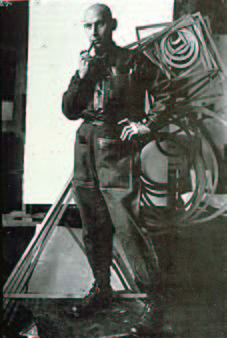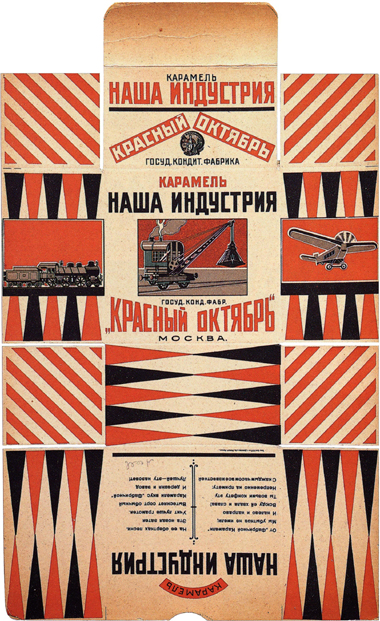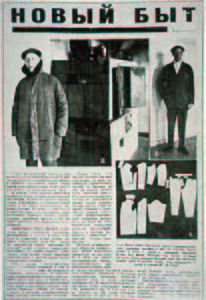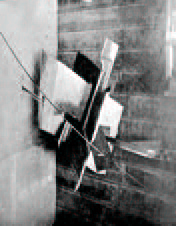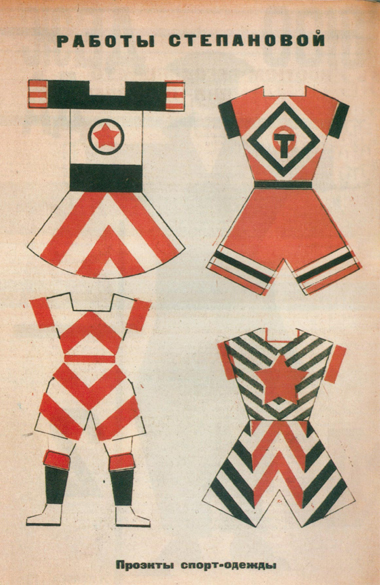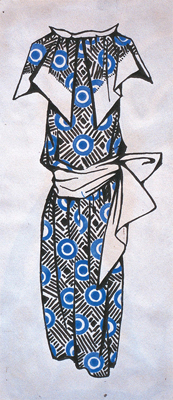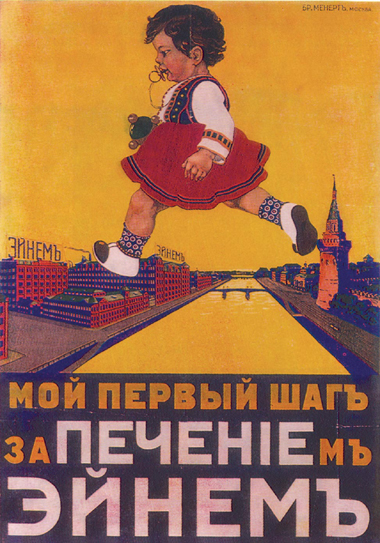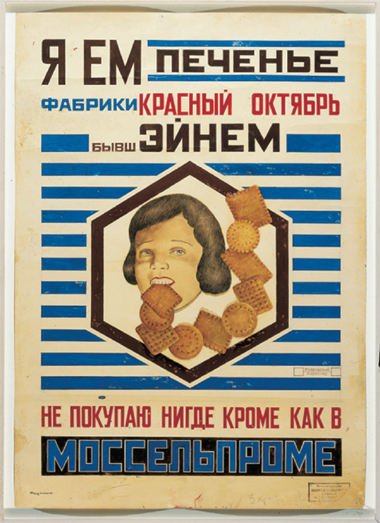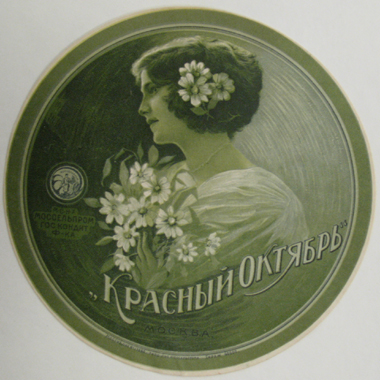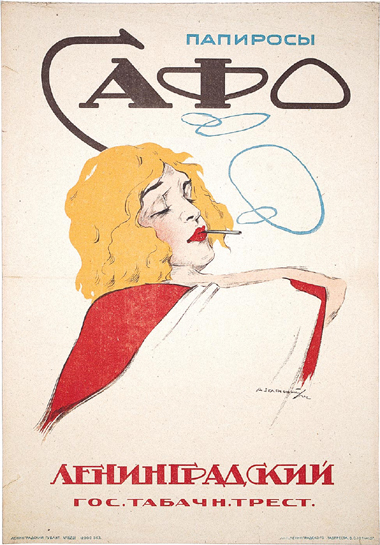03 2009
“Into Production!”: The Socialist Objects of Russian Constructivism
In the first issue of the Russian avant-garde journal Lef, in 1923, the Constructivist theorist Osip Brik wrote a brief article with the title “Into Production!”. Taking Aleksandr Rodchenko as his example, he opens: “Rodchenko was an abstract artist. He has become a constructivist and a production artist. Not just in name, but in practice.” He continues: “Rodchenko knows that you won’t do anything by sitting in your own studio, that you must go into real work, carry your own organizational talent where it is needed – into production.”[1] Brik was one of a group of theoretically-informed, Marxist critics and writers within the Moscow Institute of Artistic Culture (or INKhUK) who began promoting the so-called “Productivist” platform of Constructivism in the fall of 1921. Some of the most prominent Constructivist artists, such as Vladimir Tatlin, Karl Ioganson, Varvara Stepanova, Liubov Popova, and of course Rodchenko, attempted in various and significantly different ways to enter into Soviet mass production after the Russian Revolution. Yet if the debates leading to the formulation of Constructivism and Productivism in 1921 had emphasized “laboratory work,” industrial technology and engineering, a great deal of Productivist work ended up being less about technology and the factory, and more about the invention and theorization of new kinds of useful material objects that would transform everyday life under socialism. In this essay, I consider these artists’ different models of “production art,” and suggest that the Productivist idea of the “socialist object,” in particular, might still be relevant to radical cultural production today.
I begin with what we might call the most “pure” model of Productivism: the Constructivist sculptor Karl Ioganson’s decision to stop working as an artist and start working at a metal rolling factory in Moscow instead. Ioganson had been a signatory of the original Constructivist program and had exhibited his Spatial Constructions at the famous OBMOKhU, or Society of Young Artists, exhibition in the spring of 1921 alongside his Constructivist colleagues Rodchenko and the Stenberg brothers. As art historian Maria Gough recently discovered in her groundbreaking research on Ioganson, when he disappeared from the art historical record in 1923, he had in fact taken a job as a metal cutter at the Krasnyi Prokatchik (Red Roller) factory in Moscow.[2] While working there, he invented a “finishing machine,” which he described as a mechanized system for the treating of aluminum, tin and lead that would raise the productivity of labor by 150%. He thus fulfilled the goal of becoming an “inventor at the bench,” a true worker at the factory workbench who is also an inventor, rather than an artist fulfilling a managerial-designer role; in other words, as a Productivist he was not be alienated from the other workers. Yet as Gough points out, by inventing a machine that raised productivity, he chose a side, as it were, in the conflict between Party bureaucrats who called for increased productivity through speeding up labor, and defenders of workers’ rights, who fought against the exploitation of workers in the name of socialist production. Ioganson would further compromise himself within this conflict by eventually leaving the workbench and working exclusively as a factory Party agitator and production organizer – a predictable outcome at that time for a literate member of the intelligentsia who chose to engage in proletarian labor.
As Gough argues, the model of Productivism represented by Ioganson was theorized by the Productivist critic Nikolai Tarabukin, famous for his book From the Easel to the Machine (Ot mol’berta k mashine), who argued that the role of the Constructivist artist in production should not be as a designer of utilitarian objects – which for him was a practice linked to the outmoded handicraft tradition – but rather as an engineer of production itself. “The artist-producer (khudozhnik-proizvodstennik) in production,” he wrote, “is called upon, first of all, to design the process aspects of production. For the worker in production, the process of production itself – which is but the means of the object’s manufacture – becomes the goal of his activity.”[3] Ioganson was the only Constructivist who fulfilled Tarabukin’s brief of entering into the process of production itself, embodying the Constructivist fantasy of the artist-engineer working in the metal industry – by far the most valued of industries in the Bolshevik hierarchy of industrial labor, and an area of production that was exclusively masculine. But in doing so, he disappeared completely from the artistic community of which he had formed a vital part.
Mikhail Kaufman, Aleksandr Rodchenko, 1922
Rodchenko also participated in this masculine industrial fantasy. In Brik’s article “Into Production!”, he referred to Rodchenko’s “iron constructive power” – embodied in the famous 1922 photograph of Rodchenko dressed in workboots and prozodezhda, or “production clothing” of his own design, posing in front of his own Spatial Constructions of 1920-1921 (in collapsed form), poised to leave such “laboratory work” behind and enter work in some technological or engineering-based factory. But unlike Ioganson, he never did: the dream of heavy industry appeared instead as illustrations of industrial machines on little objects of everyday consumption, such as his design for a mass-produced box for “Our Industry” brand caramels from the state-owned factory Red October. Vladimir Tatlin’s technological ambitions suffered a similar fate. He designed his famous technological marvel, the Monument to the Third International, in 1919; although never built, it would have been a feat of engineering with four rotating glass buildings suspended from within a spiral iron frame 400 meters high. But in 1924, he was earnestly designing mundane stoves and pots and pans for proletarian kitchens. Tatlin relinquished the fantasy of the metalworking factory – which was, in any event, a small sector of the relatively primitive Soviet economy – in favor of designing industrial prototypes for simple, necessary objects of everyday life at its most basic level of need: the warm winter coat, the hygienic men’s leisurewear suit, the efficient wood-burning stove – all illustrated in a 1924 article about Tatlin’s work in the popular magazine Krasnaia panorama [Red Panorama], under the title Novyi byt (the new everyday life). “The time for ‘Americanized’ stoves in the conditions of our Russian everyday life (byt) has not yet arrived,” he told his friend, the critic Nikolai Punin. “We need things as simple and primitive as our simple and primitive byt.”[4]
Aleksandr Rodchenko and Vladimir Mayakovsky, Box for Our Industry caramels, 1923
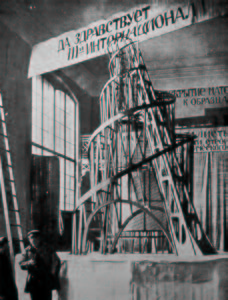
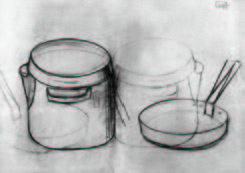
- Photograph of Vladimir Tatlin with his Monument to the Third International, 1920.
- Vladimir Tatlin, Designs for clothing and a stove, illustrated in the article “Novyi byt,” Krasnaia panorama, no. 23, 1924.
- Vladimir Tatlin, Corner Counter-Relief, no. 133, 1915. Aluminum and tin sheeting, oil pigment, priming paint, wire, fastening components, dimensions unknown. No longer extant.
- Vladimir Tatlin, Sketch for a multi-purpose metal pot, 1923.
To make sense of this shift in Constructivist practice – from fantasies of engineering to a deep engagement with the construction of a new everyday life under socialism – we need to understand the Bolshevik theory of everyday life as it was articulated in the mass campaign for the “new everyday life” or novyi byt. Party leader Leon Trotsky’s 1923 book, Questions of Everyday Life (Voprosy byta) argued that the grand ideals of the revolution would never be realized, if people did not change the way they lived their lives at the most basic, everyday level, in their homes and within their families.[5] To this end, he called for the liberation of women from domestic slavery; the socialization of childcare; and the liberation of marriage from private property relations. These ideas are visualized in the many propaganda posters from this time promoting the novyi byt, which contrasted images of women enslaved by traditional domestic objects, on the one hand, with images of women moving freely about the emptied spaces of the new, as yet still mostly imagined, public dining halls, laundries, and daycare centers, on the other.[6] Trotsky and these posters follow the standard Russian practice of seeing byt as an area of life most heavily associated with women; problems of byt were women’s problems. They would be solved by removing material life from the control of the individual and family entirely, through the construction of collective institutions. The essential femininity of byt itself was never questioned in Bolshevik thought. The idea that sexual equality in the home could be brought about simply by having men share in everyday burdens – and pleasures – was essentially inconceivable.
The Productivists, on the other hand, defied this conventional gendering of experience inherited from the bourgeois social order by working to transform everyday life from within, through the creation of new objects at the everyday level of stoves, clothing and caramel boxes. [7] The young Productivist theorist Boris Arvatov challenged both Trotsky’s call for the eradication of existing byt, and Tarabukin’s insistence on the superiority of industrial process over the production of objects, by offering a new theory of the object under socialism. Arvatov’s pivotal essay “Everyday Life and the Culture of the Thing” (Byt i kul’tura veshchi) from 1925 attempted to imagine how socialism would transform passive capitalist commodities into active socialist things.[8] He called for “the thing as the fulfillment of the physiological-laboring capacities of the organism, as a social-laboring force, as an instrument and as a co-worker.” These new socialist objects, connected like “co-workers” with human practice, would produce new experiences of everyday life, new relations of consumption, and new human subjects of modernity (“EL,” p. 124). For Arvatov, proletarian culture would emerge not by transcending material life or byt, but by “organically” and “flexibly” working within it in order to transform it in a process of “everyday-life-creation” (bytotvorchestvo) (“E.L.,” p.121). Organic and flexible are the right terms to describe Tatlin’s willingness to direct his artistic practice toward the kinds of things that were really needed in the contemporary conditions of Soviet byt, despite the fact that it involved a radically different, and less valued, kind of “creation” from his previous avant-garde endeavors. In this way, the collective entry of Productivism into everyday life challenged the gendered hierarchies of modern art.
Yet Tatlin’s dogged insistence on a primitive material culture of necessity prevented his objects from fully addressing Arvatov’s concern with how the commodity form and its desires would be transformed within the everyday life of socialist modernity. The socialist objects of Productivists such as Rodchenko and Popova, in contrast, engaged directly with the contradictory consumer culture of the early Soviet Union. In the second issue of the journal Lef, which was dedicated to Popova after her premature death at age 35, the Lef editors wrote, “Popova was a Constructivist-Productivist not only in words, but in deed. When she and Stepanova were invited to work at [the First State Cotton-Printing] factory, no one was happier than she was. Day and night she sat making her drawings for fabrics, attempting in one creative act to unite the demands of economics, the laws of exterior design and the mysterious taste of the peasant woman from Tula.”[9] According to the Lef editors, Popova aimed to not only solve technical problems of utilitarian form (“the laws of exterior design”), but also to contribute to the new socialist economy (“the demands of economics”) and appeal to consumer desire (“the mysterious taste of the peasant woman from Tula”). Unlike Tatlin, who once dismissed the subjective taste of gentlemen who liked to wear traditional, “beautiful” men’s suits, Stepanova and Popova committed themselves more deeply and systematically to solving the “mystery” of consumer desire in modernity.
Although textile design had been a traditionally feminine practice associated with the applied and decorative arts rather than advanced industrial production, in the context of the Constructivist leveling of the hierarchy of fine and utilitarian arts, their work for the factory in fabric design was not seen as a step down or away from Constuctivism – as the laudatory words of the Lef editorial make clear. They attempted to define their role at the factory as that of the Productivist artist-engineer, demanding of the administration that they be involved in production decisions and work in the industrial laboratories of the factory. Nor was their work categorized by critics as somehow feminine; rather, they were cast as Constructivist pioneers. The major critic Iakov Tugendkhol’d, for example, called Popova’s textile design work “a breach in the Bastille of our factory conservatism.”[10]
This was the historical moment of the semi-capitalist New Economic Policy (NEP), instituted in 1921, which partially legalized private trade and private manufacture as a way to jumpstart the struggling Soviet economy after the War Communist economy of the Civil War years; state-owned businesses now had to turn a profit, and therefore generally made safe and conservative design choices. Many mass-produced visual objects of the early years of NEP offer vivid illustrations of what we could call, following Tugendkhol’d, the “conservatism” of the commercial visual culture of NEP: objects such as decorated menus, for example, made available for free to restaurateurs and covered with traditional advertising images touting privately held wine, chocolate, and fashion stores; or advertising posters for both private and state-owned businesses. I have not been able to locate any advertisements for the First State Cotton-Printing Factory, where Popova and Stepanova worked, but advertising posters for other state-owned fabric and clothing trusts of the time correspond to the NEP market for fashion that appeared shortly before then, showing people posing in elegant, fashionable clothing; and one poster even shows a drawing of a model on a stage in a fashion show.
Popova and Stepanova knew that their work at the Soviet state-owned factory would have to respond to this NEP market for fashion; when they demanded that factory management allow them to participate in production, they also demanded “contact with tailors, fashion ateliers and magazines” and “work on promoting the products of the factory in the press, advertising and magazines … [and] work on designs for window displays.”[11] Stepanova’s response to NEP fashion was largely one of outright refusal: her well-known designs for sport clothes, for example, are linear and androgynous, seemingly anticipating a socialist future of class and sexual egalitarianism. The sports clothes were illustrated in Lef, where she propagated them in her article “Today’s Clothing Is Production Clothing.” “Fashion,” she wrote, “which psychologically reflects our everyday life [byt], habits and aesthetic taste, is giving way to clothing organized for working in various branches of labor.”[12] Popova, in contrast, drew designs for dozens of fashionable women’s dresses that incorporated her fabric designs, in an attempt to imagine an egalitarian form of fashion.
Varvara Stepanova, Designs for sports clothes, 1923
Walter Benjamin, preeminent theorist of mass culture and socialism, asked optimistically in his Arcades Project: “Does fashion die (as in Russia, for example) because it can no longer keep up the tempo?”[13] His question implies that only the tempo of actual social change brought about by revolution can obliterate the lure of fashion’s endless cycle of novelty. Yet an editorial in the first post-revolutionary issue of the women’s magazine Zhurnal dlia khoziaek (The Housewives’ Magazine) in 1922 declared in ringing tones: “our readers may think that fashion has died out . . . but our old friend fashion, powerfully ruling the female half of the human species, had no intention of dying!”[14] The many elegant Parisian dress patterns published in Soviet women’s magazines like The Housewives’ Magazine were directed at women buying fabric and then sewing at home or ordering dresses from small workshops. The mass production of clothing had been almost nonexistent in prerevolutionary Russia, and the idea of cheap, factory-produced stylish clothing that would be available to everyone was still largely utopian, given the primitive state of Soviet clothing production.
Popova’s fashionable dress designs, in contrast to the foreign patterns published in the magazines, were meant to be mass-reproducible within the limited resources of Soviet clothing production. (Even though, unlike her fabric designs, they were never put into production.) Their main visual interest stems not from the expensive fabrics and complex cuts of the fancy foreign patterns, but from the bold graphics of her fabric design, such as in a dress she designed using her blue, black and white optical “target” fabric. Compared to the richly gradated shading of her earlier Suprematist-inspired series of paintings, the Painterly Architectonics from 1916-1919, the fabric designs can be seen as a kind of end point in her consciously Constructivist move away from the individual, sensual touch of painting toward more anonymous, linear forms based on the industrial model of mechanical drawing. The way the earlier paintings conjured spatial illusionism is retained, but graphically simplified and transformed in the fabric designs. Popova re-creates the stylish effects of Western flapper-style fashion through highly simplified means: the dress is given its shape through the sash rather than tailoring, and the collar is attached to the dress in a rudimentary way. This dress is ready for mass production.
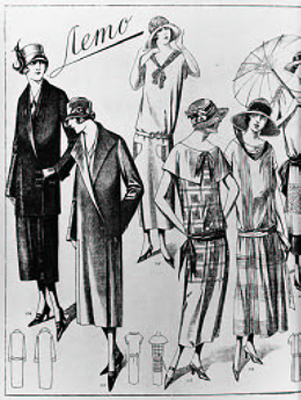
- Foreign fashion patterns illustrated in The Housewives’ Magazine, 1925
- Liubov’ Popova, Design for a dress, 1923-4, india ink on paper
It also challenges fashion’s conventional production of femininity. Compared to the more discreet dresses in Soviet fashion magazines that resemble this dress, with their delicately draping collars, Popova’s massive collar broadens the shoulders and obliterates the chest, injecting notes of androgyny into this seemingly feminine dress. So too does the bold optical pattern of the fabric itself: the receding black holes and protruding blue targets take on a bizarre effect when repeated across the voluminous folds of the dress, turning the female body into something futuristic and mechanistic. This dress hovers provocatively between contemporary NEP fashion, in all its femininity and orientation toward consumer desire, and Constructivism’s rationalism and critique of bourgeois femininity. It is precisely this doubleness of Popova’s clothing design practice that characterizes the transitional “socialist object” of Productivism during NEP: it acknowledges the individual desires of the female consumer living her everyday life in the here and now of NEP Russia, while remaining critical of them and attempting to steer them in more feminist and collectivist directions.
Popova’s historical experience as a woman gave her contributions to Constructivist “art into life” a specificity and urgency that helped to define it. At the same time, one of the reasons that she had the historical opportunity, as a woman artist, to make such an extraordinary contribution to a major avant-garde movement, was Constructivism’s rejection of the gendered hierarchies of artistic practice and its openness to working within the traditionally feminized domain of everyday life. Rodchenko’s collaboration with the revolutionary poet Vladimir Mayakovsky, called Reklam-Konstruktor (Advertising Constructor), for example, which produced advertisements and other commercial designs to promote Soviet state-owned businesses, is such an instance of dedicated Productivist work within everyday life by male artists. We recall that Osip Brik celebrated Rodchenko as a true production artist with “iron constructive power,” but in the same article he also complained about the consumer-oriented culture of NEP, which was inhospitable to Productivist ambitions of transforming industrial production: “Rodchenko is patient. He will wait. Meanwhile he is doing what he can – he is revolutionizing taste, clearing the ground for a future material culture.”[15] This passive terminology of “waiting,” “doing what he can,” and “clearing the ground,” suggests the mundane, repetitive and feminized nature of work in everyday consumption. But Rodchenko himself did not consider his work to be a lesser substitute for (the fantasy of) work in heavy industry – he was deeply engaged in his extensive advertising and package design for petty objects of everyday consumption such as cookies, cigarettes, and candy. Rodchenko bragged that “All of Moscow was covered with our work . . .. We made about fifty posters, about one hundred signboards, wrappers, containers, illuminated advertisements, advertising columns, illustrations in magazines and newspapers.”[16] The sheer scale and seriousness with which they undertook this project signals their indifference to the usual expectations of avant-garde masculinity.
Mayakovsky’s advertising jingles address working-class Soviet consumers directly and without irony; for example, an ad for one of the products of Mossel’prom, the state agricultural trust, reads: “Cooking oil. Attention working masses. Three times cheaper than butter! More nutritious than other oils! Nowhere else but Mossel’prom.” It is not surprising that Constructivist advertisements would speak in a pro-Bolshevik, anti-NEP-business language, yet the picture of the Reklam-Konstruktor advertising business is more complicated. Many of their commercial graphics move beyond this straightforward language of class difference and utilitarian need to offer a theory of the socialist object.
In contrast to Brik’s claim that in this kind of work they are merely “biding their time,” I propose that their advertisements attempt to work out the relation between the material cultures of the prerevolutionary past, the NEP present and the socialist novyi byt of the future with theoretical rigor. They confront the question that arises out of the theory of Boris Arvatov: What happens to the individual fantasies and desires organized under capitalism by the commodity fetish and the market, after the revolution? One of their most striking advertisements is their 1923 poster for Red October brand cookies from Mossel’prom. Mayakovsky’s slogan seems to speak prosaically in the voice of the grinning girl chomping on cookies: “I eat cookies from the Red October factory, the former Einem.” The second part of the slogan is significant and introduces the temporal complexity of the poster: Einem was a major confectionery factory and well-known brand name before the revolution, so the slogan reminds viewers of the prerevolutionary life of this Soviet commodity. Rodchenko and Mayakovsky even seem to deliberately recall an artifact from the material culture of the pre-revolutionary past: an Einem advertising poster from the early 1900s, which also featured a single little girl, skipping across the Moscow River from the Kremlin toward the Einem factory, which lies on an island in the Moscow River to this day.[17] The slogan of this earlier poster, “My first step is for Einem cookies”, is also in the little girl’s own voice, suggesting that in his Red October rhyme, Mayakovsky took his cue from this prerevolutionary ad or others like it. In the temporal narrative of text and image, we see the capitalist past of Einem and the NEP present of Mossel’prom moving toward the socialist future of Red October – a movement literalized in the image of the spiral of cookies snaking their way into the girl’s mouth. This image can be understood as a “dialectical image”, as theorized by Walter Benjamin in the Arcades Project: “what has been comes together in a flash with the now to form a constellation.”[18] This constellation offers the “flash of recognition” to understand the socialist future. It works to make consumer desire legible.
Menert Brothers, Advertisement for Einem cookies, early 20th century.
Aleksandr Rodchenko and Vladimir Mayakovsky, Advertising poster for Red October cookies, 1923
Benjamin imagined that the dreaming collective of bourgeois culture would awaken from the “dream sleep” of the commodity phantasmagoria into a socialist culture, when the wish-images of what he called the “ur-past” -- the mythic, egalitarian society of material abundance -- are made visible in the newest technological forms. Wish images of the harmonious ur-past had left their traces embedded in the mass material culture of the recent, outmoded past -- for him, in the material culture of the arcades, in the past of his grandparents -- and would have to be redeemed in the new material forms of modernity in order to engender a socialist future.[19] Rodchenko and Mayakovsky’s designs carry out Benjamin’s prescription to the letter: they refer to the traces of the recently outmoded past -- the old-fashioned engravings of industrial machinery on the “Our Industry” caramel box, for example, or the little girl from the prerevolutionary Einem poster -- and attempt to awaken them by citing Constructivist objects like the hexagon encircling the Red October girl, taken from the form of one of Rodchenko’s geometric Spatial Constructions of 1920-21, and the overall modernist graphic form itself, into the “now” of Mossel’prom.
The Red October cookies are the NEP era substitutes or place holders for the grander socialist objects that will eventually be produced by socialist industry, and can be understood as analogous to what the psychoanalyst D.W. Winnicott called the “transitional objects” of the oral phase of early infancy: the pacifier or chewed-on corner of the blanket.[20] The transitional object, which Winnicott also calls “the first not-me possession”, allows the infant to adjust to the “reality principle” of the absence of the gratification of the mother’s breast – the true desired object. The true desired object of the Constructivists is the socialist object, which will use the most advanced technological forms of industry to amplify the sensory experience of its human user, and awaken him or her from the dream sleep of the commodity phantasmagoria. But in the moment of NEP, the Constructivists adjust to the reality principle that the large-scale production of such objects is not yet possible and concentrate their graphic efforts on laying bare the processes of object desire at their most originary, bodily level. Their advertisements are “transitional objects” that explore the transition from the fetishistic capitalist desires fomented by the commodity to the equally strong, but now explicit and comprehensible desires for the semi-socialist objects of NEP – an exploration that will eventually result in fully organized desires for socialist objects themselves.
Anonymous, Red October advertising image, ca. 1922
Nostalgia for the old way of life of Einem is also evoked by the visual figure of the Red October girl, who recalls but also challenges the prerevolutionary Einem poster’s sentimental image of the plump baby girl. Rodchenko has added thinly penciled brows and bright red lipstick to his little girl, giving her a vaguely sexualized, adult look that sits uneasily between two recognizably desirable images of femininity: either the wholesome little communist girl one would expect to eat Red October cookies, or the figure of the sexy modern woman who was associated with western advertising. A Red October commercial design from as recently as 1922 (the year before Rodchenko and Mayakovsky took over Mossel’prom’s commercial image), showing a pretty brunette with white flowers in her hair and arms, staring off dreamily into space, allows us to take the measure of Rodchenko’s distance from the art-deco visual language of such conventional advertising illustrations of the time. Or we might compare the Red October girl to the female figure in a contemporary advertisement for the Leningrad State Tobacco Trust, by the poster artist Aleksandr Zelinskii, advertising Sappho brand cigarettes. The image of the yellow-haired, heavily rouged woman, eyes closed in a seemingly narcotic trance induced by the cigarette nestled between her bright red lips, evokes the “exotic” lesbian sexuality of the ancient Greek poet Sappho herself. She could also be a figure of Benjamin’s “slumbering” collective. The Constructivist advertisements refuse such veiled, fetishistic imagery that intimates an oral sexuality in favor of a more explicit depiction of the oral drive. The Constructivist ads seem to say that the objects of mass industrial culture have a powerful hold on the human subject, but the difference between capitalism and socialism is that under socialism the nature of that hold will be articulable to the subject, even if it cannot be immediately altered or overcome. The Constructivist drive toward transparency was not just material, as in the systematic Spatial Constructions of Ioganson and Rodchenko, or Popova’s easy-to-make flapper dress, but psychological, offering a critical understanding of the excessive nature of consumer desire – the “flash of recognition” – that would be necessary for waking up from the commodity phantasmagoria of capitalism. It is this transparency of object desire that the Rodchenko-Mayakovsky advertisements map out, contravening Peter Bürger’s well-known claim that when avant-garde art enters into life as a form of mass culture, “it is an art that enthralls.”[21]
Aleksandr Zelenskii, Advertisement for Sappho cigarettes, 1924
In contrast to the dreamy, art-deco woman in the earlier Red October ad, and in contrast to the swooning “Sappho,” the Red October girl could be described as a “conscious” female subject. Of course this strange, jokey figure of a girl is not meant to actually represent the newly conscious woman emancipated by Bolshevism. But she functions as a sign for the discourse of female consciousness and emancipation, which was bound up within Constructivism with a set of ideas about new, active objects that can transform everyday life. Rodchenko’s wife Stepanova was his frequent model for this conscious Soviet woman, in photographs and photomontages published on book covers and in mass journals, such as his cover design for a book called The New Everyday Life and Art (Novyi byt i iskusstvo), in which a confident Stepanova in a worker’s headscarf grins out at us much like the Red October girl.[22] Women and the novyi byt were connected, in Rodchenko’s imagination as much as in the Bolshevik discourse of women’s emancipation. But this connection did not lead him, like the Bolsheviks, to denigrate or attempt to eradicate byt.
There is a moment when Rodchenko uncharacteristically makes explicit this connection between women’s emancipation and the ideals of Constructivism. In a letter home from Paris, where he went in 1925 to design the Soviet section of the Exposition Internationale des Arts Décoratifs et Industriels, Rodchenko would write, “The light from the East is not only the liberation of workers, the light from the East is in the new relation to the person, to woman, to things. Our things in our hands must be equals, comrades, and not these black and mournful slaves, as they are here.”[23] His turn of phrase suggests that for him, the rejection of the passive commodities he saw in Paris was associated with the rejection of Parisian conventions of passive femininity, and of women as sex objects. Rodchenko’s letters refer repeatedly to the objectified women of Paris – women he sees on the streets with their short tight skirts; women performing naked in cabarets; in short, “the cult of woman as thing”.[24] In contrast, he imagines a new relation to woman in the Soviet east, and although he does not go on to theorize or describe this new relation, we can surmise that he imagined woman as an equal and a comrade somewhat on the model of the Soviet campaign for the emancipation of women. His letters demonstrate that he certainly thought of his most famous Constructivist object, the interior of a Workers’ Club that he designed for the Soviet section of the Paris exhibition, as a “comrade”. He writes tenderly of the cleanliness and illumination of his club, of the way that its material forms repulse the muck of Paris, symbol of the eroticized excess of the commodity system: “It’s true that it’s so simple and clean and light that you would never willingly track dirt into it.” Rodchenko projects his desire onto his technological forms, warming and humanizing them for their collective social function. Even if the content of this desiring projection may not be rendered fully conscious, neither is it repressed in the final material incarnation of the object. The desire can begin to be recognized and directed toward collective ends.
In the sense that his club responds to both socio-economic demands and the demands of the human body, including unconscious ones, it offers one possible answer to Benjamin’s question from the Arcades Project:
When and how will the worlds of form that have arisen in mechanics, in film, machine construction and the new physics, and that have overpowered us without our being aware of it, make what is natural in them clear to us? When will the condition of society be reached in which these forms or those that have arisen from them open themselves up to us as natural forms?[25]
The Constructivist object would ideally utilize only the most modern technology, and work to “make it clear” and “open it up” to the human subject as a comrade would in conversation. (Here is Rodchenko again, musing on the problem of “things” as he views the Paris commodities: “the person learns how to laugh and be happy and converse with things.”[26]) Yet Rodchenko’s club interior, while ingeniously designed in the geometric, functionalist forms of the international modernist movement, is in fact hand-crafted out of wood; like the traditional printed cotton calico fabric of Popova and Stepanova and the printed cardboard of the Mossel’prom caramel box, it is not a bona fide example of the newest mass-produced technological inventions. His economical use of the wood was necessitated by the budgetary constraints on the exhibition, but also represented Constructivism’s overall commitment to coping with the material scarcity of the NEP economy, and thus the needs of existing Soviet byt.
* * *
Like Tatlin’s efficient stove, and Popova’s rational yet fashionable dresses made from her mass produced fabrics, the Red October girl in Rodchenko’s poster – grinning down from her perch on top of the Mossel’prom kiosks that dotted Moscow – embodies the Productivist entry into Soviet everyday life. We can describe all of these Productivist works as “transitional objects” that explore the transition from the fetishistic capitalist desires fomented by the commodity to the equally strong, but now explicit and comprehensible desires for the semi-socialist objects of NEP. This exploration would, eventually, result in fully organized desires for the socialist objects themselves. These and other Productivist objects provided the flash of critical understanding of mass culture and object desire under NEP that would be necessary for waking up from the dream sleep of capitalism into the future socialist culture. In 2009 we are still waiting to be awakened. The premise of this conference – that the “New Productivisms” of contemporary artists can continue and retool the political force of the original Productivism – is a hopeful sign. As Arvatov once said, “it’s Utopia, but we have to say it … It’s true that the situation is tragic … but it isn’t a dead-end situation. This is the situation of a man on a riverbank who needs to cross over to the other side. You have to lay a foundation and build a bridge.”[27]
[1] Osip Brik, “V proizvodstvo!”, Lef no. 1 (1923): 105-108.
[2] See Maria Gough, “Red Technics: The Konstruktor in Production,” ch. 5 in The Artist as Producer: Russian Constructivism in Revolution (Berkeley, CA: University of California Press, 2005).
[3] Cited in Gough, The Artist as Producer, p. 148.
[4] Nikolai Punin, “Rutina i Tatlin,” in N. Punin, O Tatline, ed. I.N. Punina and V.I Rakitin (Moscow: Literaturnoe-Khudozhestvennoe Agenstvo “RA,” 1994): p. 71.
[5] L. Trotskii, Voprosy byta (Moscow: Krasnaia nov', 1923), translated as Leon Trotsky, Problems of Everyday Life and Other Writings on Culture and Science (New York: Monad Press, 1973).
[6] Illustrations of such propaganda posters for the novyi byt, as well as a number of other images discussed in this essay, can be found in my book, Imagine No Possessions: The Socialist Objects of Russian Constructivism (Cambridge, MA: MIT Press, 2005).
[7] For a feminist analysis of Productivism, see my “His and Her Constructivism,” in Rodchenko and Popova: Defining Constructivism, ed. Margarita Tupitsyn (London: Tate Publishing, 2009): 143-159.
[8] Boris Arvatov, "Byt i kul'tura veshchi (k postanovke voprosa)," Al'manakh proletkul'ta (Moscow: 1925): 75-82; for an English translation, see “Everyday Life and the Culture of the Thing (Toward the Formulation of the Question),” trans. Christina Kiaer, October, no. 81 (Summer 1997): 119-128. Future references to this translation will be cited parenthetically in the body of the text as “EL.”
[9] "Pamiati L.S. Popovoi," Lef no. 2 (1924): 4.
[10] Tugendkhol’d, cited in Natalia Adaskina, “Constructivist Fabrics and Dress Design,” The Journal of Decorative and Propaganda Arts, vol. 5 (Summer 1987): 157.
[11] V.F. Stepanova and L.S. Popova, “Memo to the Directorate for the First State Cotton-Printing Factory,” unpublished manuscript, 1924, The Rodchenko-Stepanova Archive, Moscow. Cited in A.N. Lavrent'ev, “Poeziia graficheskogo dizaina v tvorchestve Varvary Stepanovoi,” Tekhnicheskaia estetika (1980): 25.
[12] Varvara Stepanova, "Kostium segodniashnego dnia -- prozodezhda." Lef no. 2 (1923): 65-68.
[13] Walter Benjamin, The Arcades Project, trans. Howard Eiland and Kevin McLaughlin (Cambridge, MA: The Belknap Press of Harvard University Press, 1999), p. 71 [section B4,4].
[14] "Modnaia khronika." Zhurnal dlia Khoziaek no. 1 (1922): 3.
[15] Osip Brik, “V proizvodstvo!”, p. 108.
[16] Rodchenko, “Rabota s Maiakovskim,” in Varvara A. Rodchenko, ed., A.M. Rodchenko: Stat'i, vospominaniia, avtobiograficheskie zapiski, pis'ma (Moscow: Sovetskii khudozhnik, 1982), p. 67.
[17] The Einem factory was renamed Red October after the revolution, and continued to operate until just recently, when the beautiful old factory building -- occupying prime real estate on its island in central Moscow -- was converted to a center for contemporary art.
[18] Benjamin, The Arcades Project, p. 462 [N2a,3].
[19] On “awakening,” see especially section K [Dream City and Dream House, Dreams of the Future, Anthropological Nihilism, Jung] in Benjamin, The Arcades Project, and Susan Buck-Morss’s evocative gloss of this idea, in The Dialectics of Seeing: Walter Benjamin and the Arcades Project (Cambridge, MA: The MIT Press, 1989), chap. 8, esp. pp. 265-75.
[20] D. W. Winnicott, “Transitional Objects and Transitional Phenomena: A Study of the First Not-Me Possession,” The Yearbook of Psychoanalysis 10 (1954): 64-80
[21] Peter Bürger, Theory of the Avant-Garde, translated by Michael Shaw. Theory and History of Literature, ed. Wlad Godzich and Jochen Schulte-Sasse, vol. 4 (Minneapolis: University of Minnesota Press, 1984), p. 54
[22] For an illustration of this book cover design, see Rodchenko and Popova: Defining Constructivism, p. 100.
[23] Aleksandr Rodchenko, “Rodchenko v Parizhe. Iz pisem domoi,” Novyi lef no. 2 (1927): 20 (letter of 4 May 1925).
[24] Ibid., p. 12 (letter of 25 March 1925).
[25] Walter Benjamin, Arcades Project, p. 396 [K3a,2], translation modified according to Buck-Morss, The Dialectics of Seeing, p. 123.
[26] Rodchenko, Letters, 4 May, p. 20
[27] “Transcript of the Discussion of Comrade Stepanova’s Paper ‘On Constructivism’,” 22 December 1921, private archive, trans. James West in Art Into Life: Russian Constructivism, 1914-1932 (New York: Rizzoli, 1990): 74-79; the quotation from Arvatov’s contribution to the discussion is on p. 76.


